Copper-clad laminate is also known as base material. È un materiale simile a una lastra formato dalla pressatura a caldo impregnando un materiale di rinforzo con resina e coprendo uno o entrambi i lati con fogli di rame, which is called a copper-clad laminate. È il materiale di base per PCB, often called substrate. Quando viene utilizzato nella produzione di schede multistrato, it is also called core board (CORE). Questo articolo presenta principalmente il flusso di processo dei laminati rivestiti di rame ad alta velocità e ad alta frequenza. Si prega di seguire l'editor per saperne di più su di esso.
High-speed and PCB ad alta frequenza copper clad laminate process
The preparation process of high frequency copper clad laminate is similar to that of ordinary copper clad laminate:
1. miscelazione della colla: La resina speciale, il solvente e il riempitivo vengono pompati nel serbatoio di miscelazione della colla attraverso una conduttura secondo una certa proporzione e mescolati. I materiali devono essere mescolati per preparare una colla viscosa con fluidità.
2. Incollaggio e asciugatura: pompare la colla mista nel serbatoio della colla, e allo stesso tempo continuously immerse the glass fiber cloth into the glue tank through the gluing machine to make the glue adhere to the glass fiber cloth. Il panno in fibra di vetro incollato entra nel forno della macchina della colla e viene asciugato ad alta temperatura per diventare un foglio legato.
3. impilare il libro dopo aver tagliato le fette appiccicose: le fette appiccicose essiccate vengono tagliate come richiesto, e le fette appiccicose (1 o più) e il foglio di rame vengono impilate e trasportate nella stanza bianca. Utilizzare una macchina automatica del libro per combinare il materiale preparato e la piastra d'acciaio dello specchio.
4. Laminazione: Invia il semilavorato assemblato dal trasportatore automatico alla pressa a caldo per la pressatura a caldo, so that the product can be kept in a high temperature, Ambiente ad alta pressione e vuoto per diverse ore, so that the bonding sheet and the copper foil are connected together, E infine diventa il laminato rivestito di rame finito con lamina di rame superficiale e strato isolante intermedio.
5. Tagliere: Dopo il raffreddamento, trim the extra side strips of the disassembled product, e taglialo in dimensioni corrispondenti secondo le esigenze del cliente.
Process analysis of high-speed and high-frequency copper clad laminates
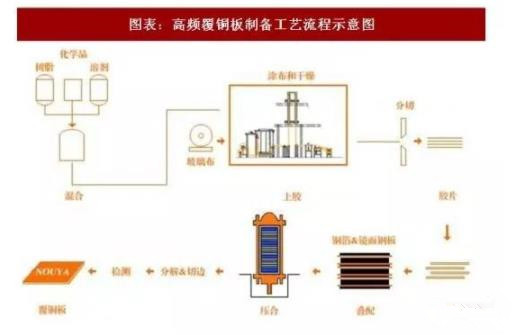
Chart: Schematic diagram of high-frequency copper clad laminate preparation process
The raw material formula directly affects the dielectric constant and dielectric loss of the copper clad laminate. The core difficulty of the process production lies in the selection of upstream raw materials and the formula ratio:
Resin:
Traditional epoxy resin has higher dielectric properties due to its higher content of polar groups. By using other types of resins such as polytetrafluoroethylene, estere di cianato, styrene maleic anhydride, PPO/APPE and other modifications Low-polarization molecular structures such as thermosetting plastics to achieve low-dielectric constant and low-loss materials.
Process analysis of high-speed and high-frequency copper clad laminates
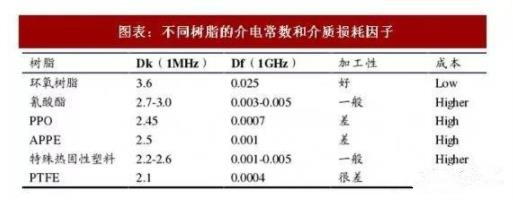
Chart: Dielectric constant and dielectric loss factor of different resins
Filler: Improve the physical properties of the board while affecting the dielectric constant
Filling materials in the manufacture of substrate materials refer to chemical materials used as resin fillers in addition to reinforcing fiber materials in the composition of substrate materials. The proportion, varietà, and surface treatment technology of the filler material in the resin for the entire substrate material all have an impact on the dielectric constant of the substrate material. I riempitivi inorganici più comunemente usati sono: talco, caolino, magnesium hydroxide, idrossido di alluminio, silica powder and alumina. L'aggiunta di riempitivi può ridurre efficacemente l'assorbimento di umidità del prodotto, thereby improving the heat resistance of the board, and at the same time, it can also reduce the thermal expansion coefficient of the board.
Process analysis of high-speed and high-frequency copper clad laminates
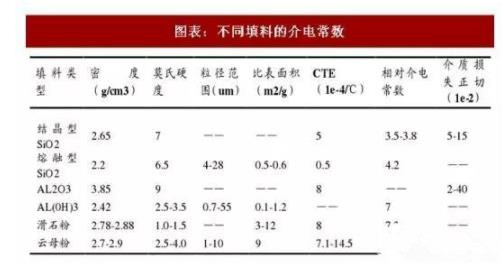
Chart: Dielectric constant of different fillers
Glass fiber cloth: reducing the dielectric constant of glass fiber cloth is an effective way to reduce the dielectric constant of the sheet
Glass fiber cloth is the main bearer of the mechanical strength of the copper clad laminate. Generally speaking, la sua costante dielettrica è superiore alla matrice resina, and it occupies a higher volume content in the copper clad laminate, Quindi è il fattore principale che determina le proprietà dielettriche del materiale composito. In the production of FR-4 copper clad laminates, Il tradizionale panno in fibra di vetro E è stato utilizzato. Although E-glass fiber cloth has good overall performance and ideal performance and price, its dielectric performance is not good and the dielectric constant is relatively high (6.6) , Che ha influenzato la sua divulgazione e applicazione nel campo ad alta frequenza e ad alta velocità. At present, I produttori di tessuti in fibra di vetro stanno anche sviluppando fibre organiche costanti a basso dielettrico, such as aramid fibers, polyether ether ketone (PEEK) fibers and acetate fibers.
Process analysis of high-speed and high-frequency copper clad laminates
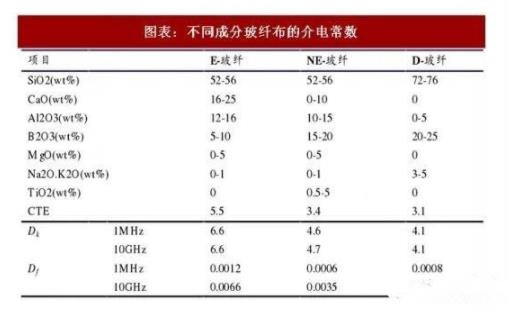
Chart: Dielectric constants of different components of glass fiber cloth
Copper foil: The surface roughness of copper foil also affects the properties of the material
The skin depth of copper foil decreases as the signal transmission inland increases. Alle alte frequenze, the skin depth of copper conductors is less than 1um, che significa che la maggior parte dei circuiti scorrerà attraverso la struttura dentaria sulla superficie del foglio di rame a causa della superficie ruvida. Influencing the flow of current will affect the power loss and insertion loss.
Process analysis of high-speed and high-frequency copper clad laminates
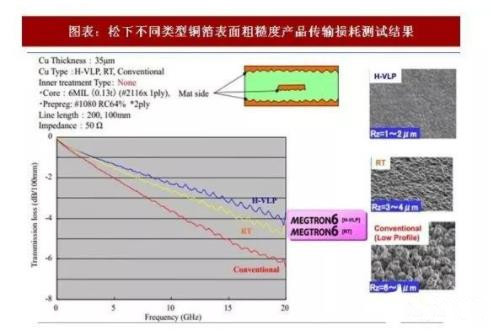
Chart: Transmission loss test results of different types of copper foil surface roughness products of Panasonic
The preparation process of high-frequency copper clad laminates is similar to that of conventional products. The dielectric constant and dielectric loss are mainly affected by raw materials, ricette di processo, and process control. I tre fattori di cui sopra richiedono la verifica a lungo termine del prodotto di applicazione a valle e l'accumulo di esperienza sperimentale. Core barriers for manufacturers of high-frequency copper clad laminates.